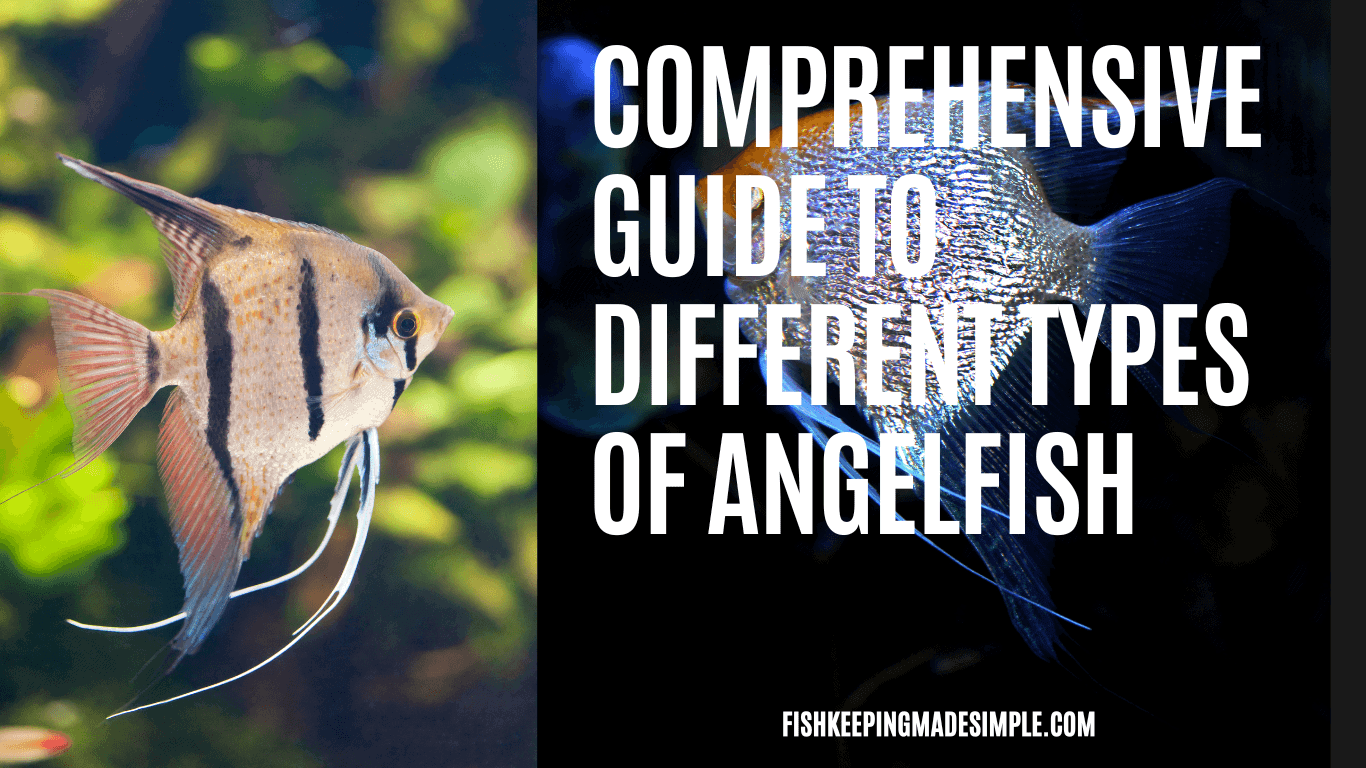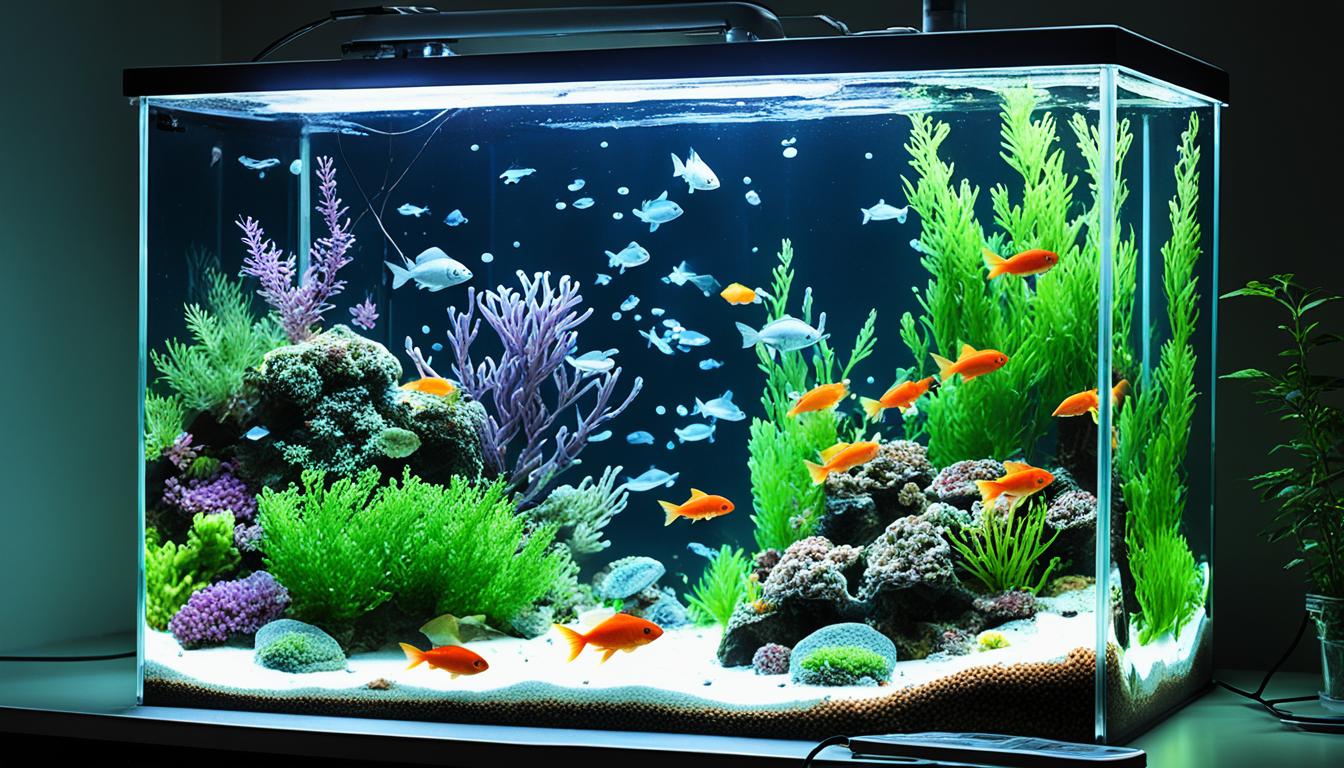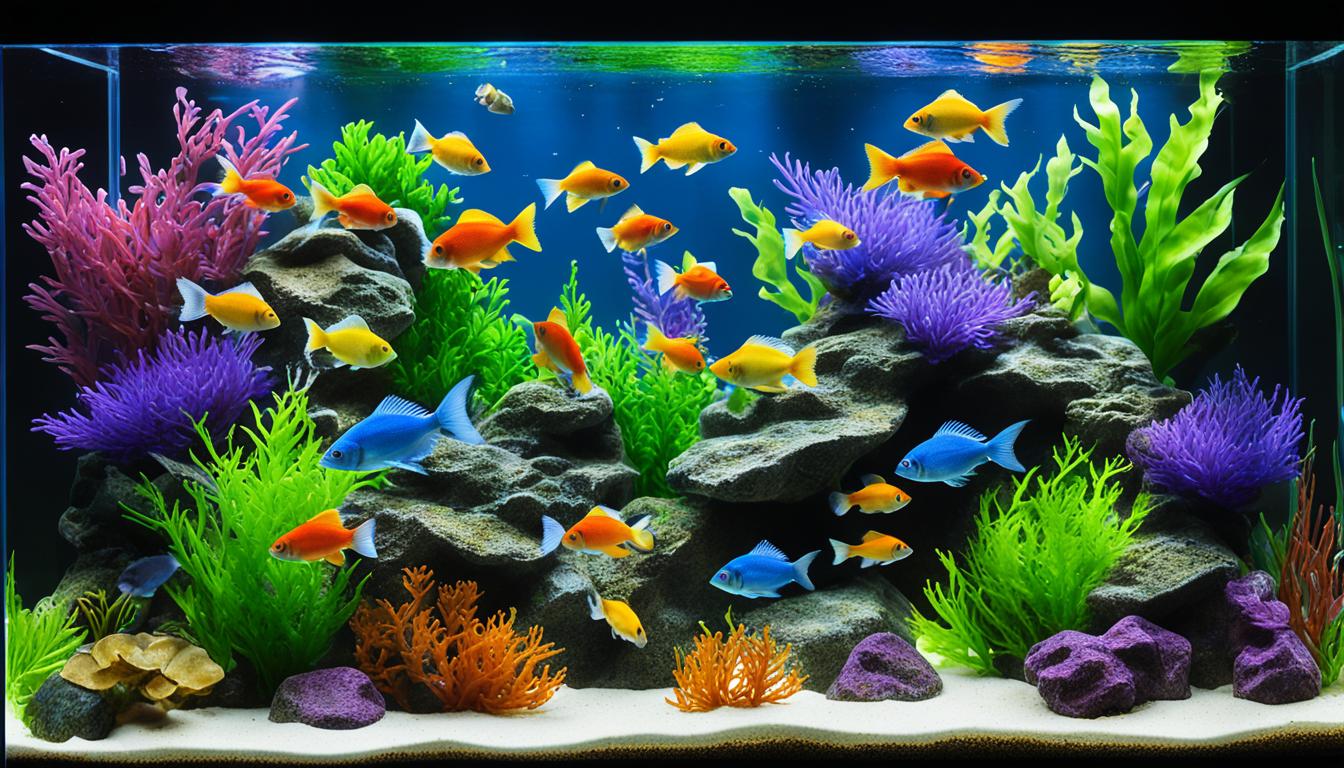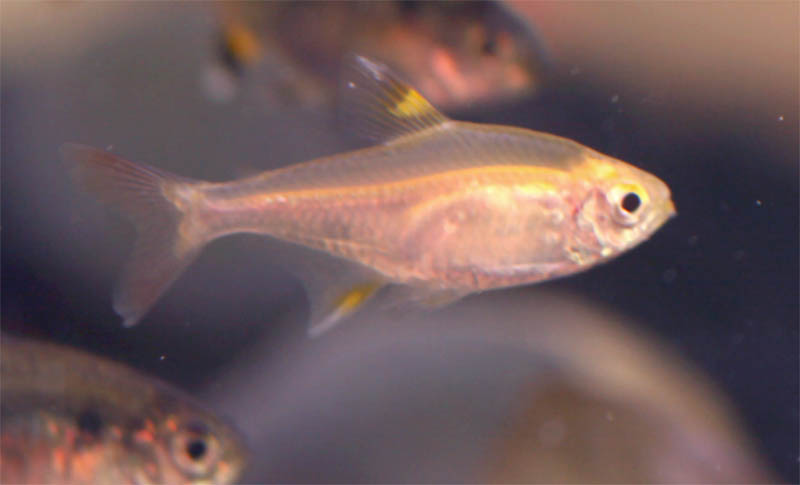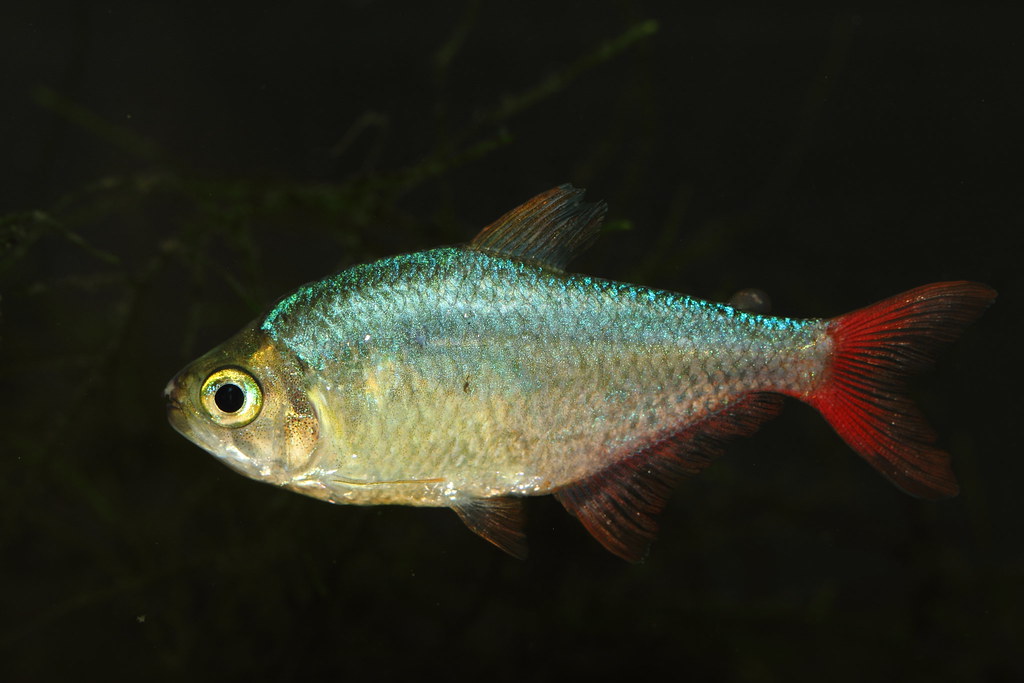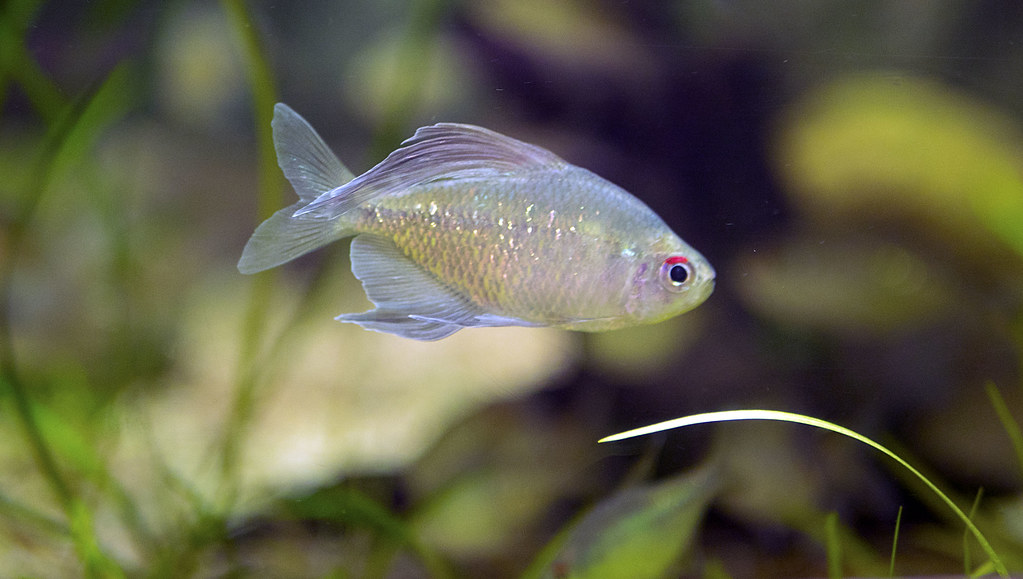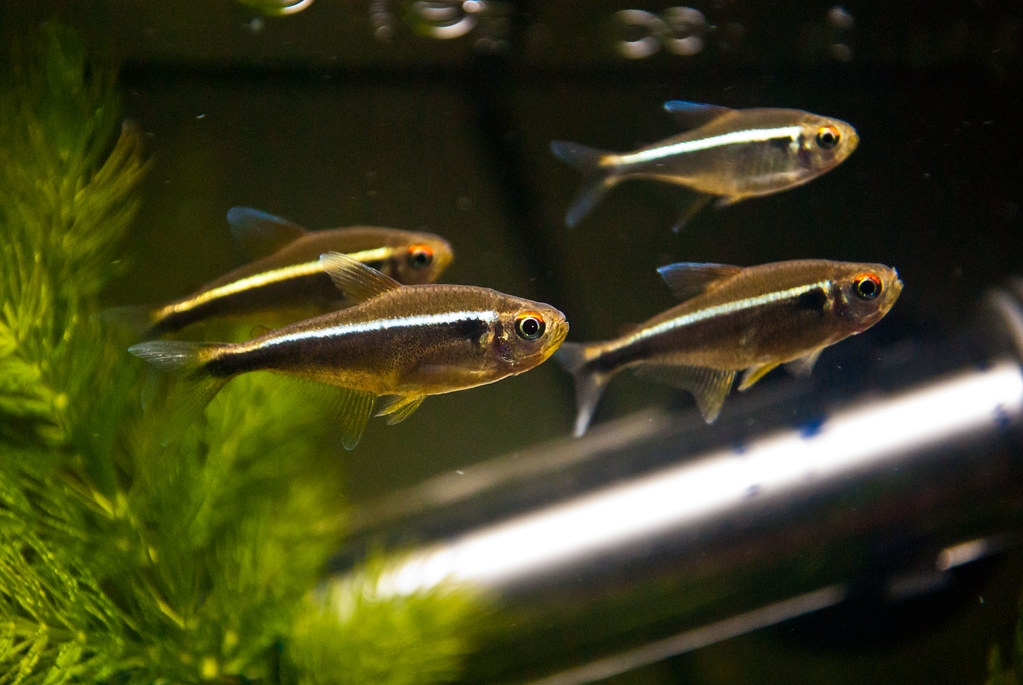Angelfish are some of the most popular and beautiful freshwater fish in the aquarium trade. These tropical fish are known for their vibrant colors, flowing fins, and unique body shapes. They are also relatively easy to care for, making them a great choice for both experienced aquarists and beginners. There are many different types of angelfish available, each with its own unique characteristics. In this comprehensive guide, we will take a closer look at the different types of angelfish and their characteristics, including their origin, appearance, size, temperament, and care requirements.
Table of Contents
Common Angelfish (Pterophyllum scalare)
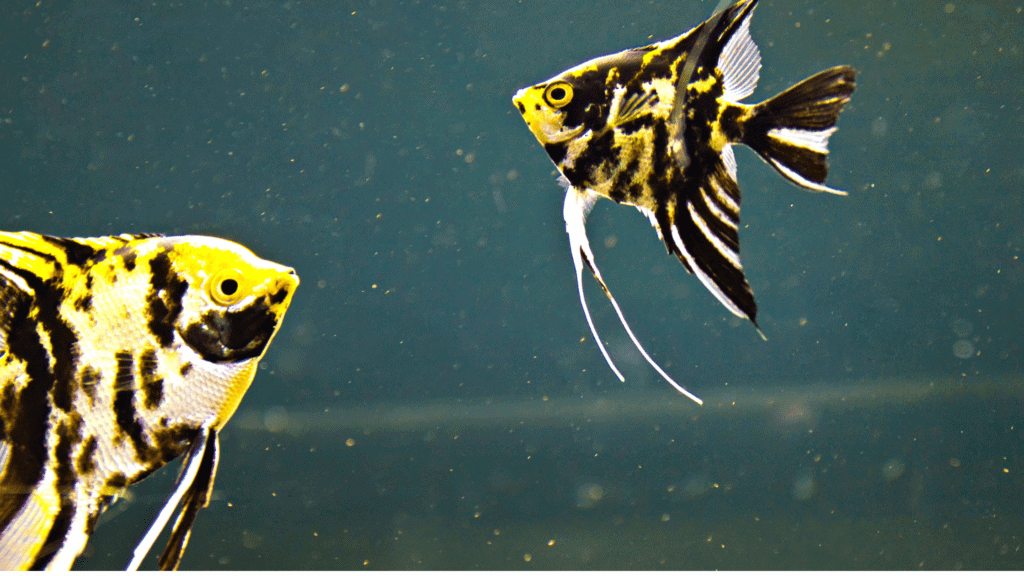
The common angelfish, also known as the scalare angelfish, is the most well-known and widely available type of angelfish. They are native to the Amazon Basin in South America and are often found in slow-moving rivers and shallow swamps.
Common angelfish are characterized by their tall, triangular body shape and long, flowing fins. They have a dark vertical stripe running down their body, which extends from their head to their tail. They also have a distinctive eyespot on their dorsal fin, which is believed to deter predators.
In terms of size, common angelfish can grow up to 6 inches in length. They have a lifespan of around 5-10 years, depending on their care and environment.
Common angelfish are generally peaceful and can be kept with other peaceful fish. However, they can be territorial and may become aggressive towards other angelfish if they are not given enough space. They are also known to nip at the fins of other fish, so it is important to provide them with plenty of hiding places and swimming space.
In terms of care, common angelfish require a well-maintained and heavily planted aquarium with a pH of 6.5-7.5 and a temperature of 78-82 degrees Fahrenheit. They should be fed a varied diet of high-quality flakes, pellets, and frozen or live foods. They also require regular partial water changes and a good filtration system to maintain proper water quality.
Silver Angelfish (Pterophyllum altum)
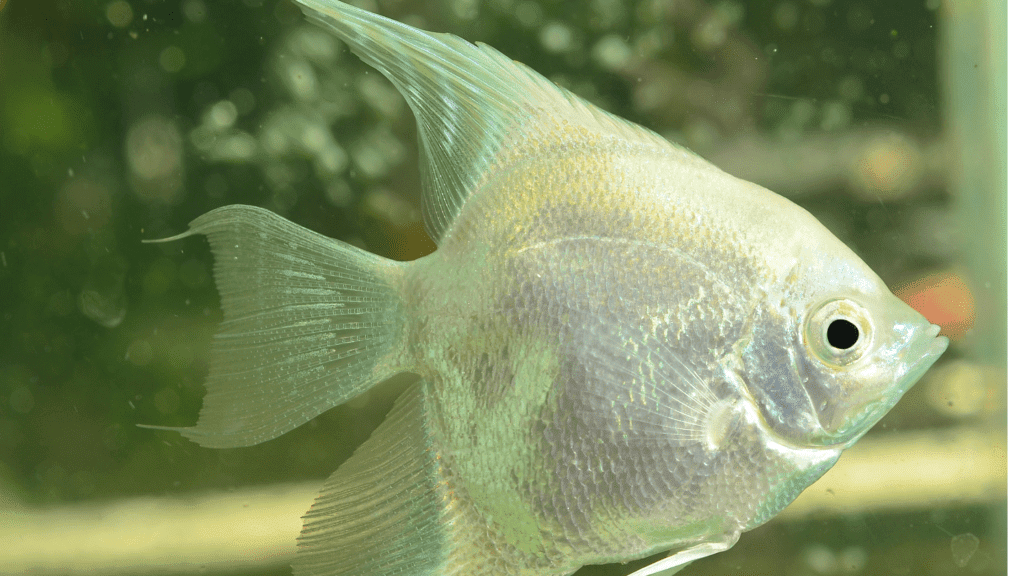
The silver angelfish, also known as the altum angelfish, is a rare and highly sought-after type of angelfish. They are native to the Orinoco Basin in South America and are found in the deep, clear waters of the Amazon rainforest.
Silver angelfish are characterized by their deep, oval-shaped body and long, flowing fins. They have a metallic silver coloration with black markings on their head and body. They also have a distinctive eyespot on their dorsal fin, similar to the common angelfish.
In terms of size, silver angelfish can grow up to 8 inches in length. They have a lifespan of around 10-15 years, depending on their care and environment.
Silver angelfish are generally peaceful and can be kept with other peaceful fish. However, they can be territorial and may become aggressive towards other angelfish if they are not given enough space. They are also known to nip at the fins of other fish, so it is important to provide them with plenty of hiding places and swimming space.
In terms of care, silver angelfish require a well-maintained and heavily planted aquarium with a pH of 6.5-7.5 and a temperature of 78-82 degrees Fahrenheit. They should be fed a varied diet of high-quality flakes, pellets, and frozen or live foods. They also require regular partial water changes and a good filtration system to maintain proper water quality.
Marble Angelfish (Pterophyllum sp.)
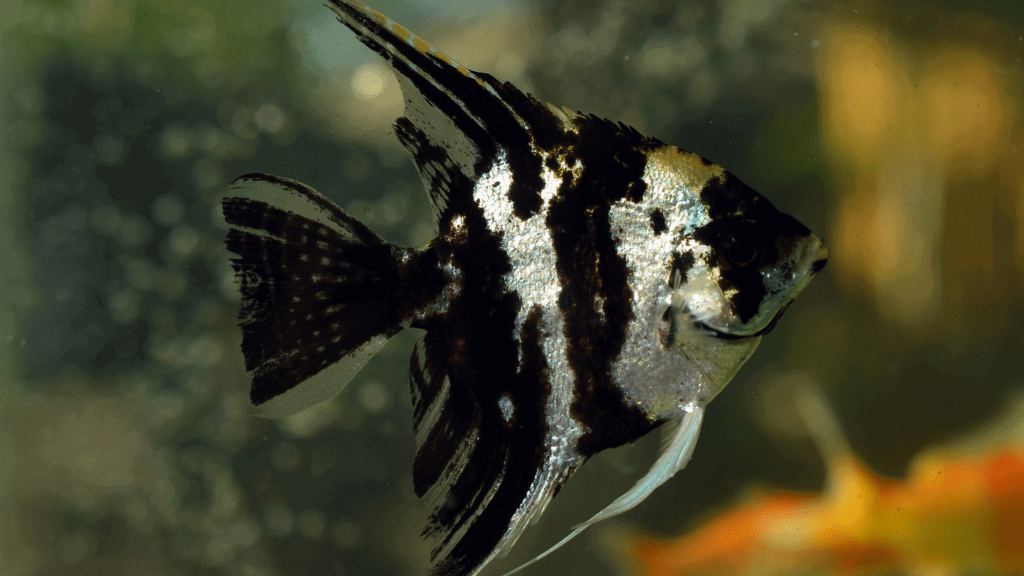
The marble angelfish is a hybrid type of angelfish that is created by breeding common angelfish with gold marble angelfish. They are not found in the wild and are exclusively found in the aquarium trade.
Marble angelfish are characterized by their tall, triangular body shape and long, flowing fins. They have a distinctive marbled pattern on their body, which can range in color from white to yellow to orange to black. They also have a distinctive eyespot on their dorsal fin, similar to the common and silver angelfish.
In terms of size, marble angelfish can grow up to 6 inches in length. They have a lifespan of around 5-10 years, depending on their care and environment.
Marble angelfish are generally peaceful and can be kept with other peaceful fish. However, they can be territorial and may become aggressive toward other angelfish if they are not given enough space. They are also known to nip at the fins of other fish, so it is important to provide them with plenty of hiding places and swimming space.
In terms of care, marble angelfish require a well-maintained and heavily planted aquarium with a pH of 6.5-7.5 and a temperature of 78-82 degrees Fahrenheit. They should be fed a varied diet of high-quality flakes, pellets, and frozen or live foods. They also require regular partial water changes and a good filtration system to maintain proper water quality.
Gold Marble Angelfish (Pterophyllum sp.)
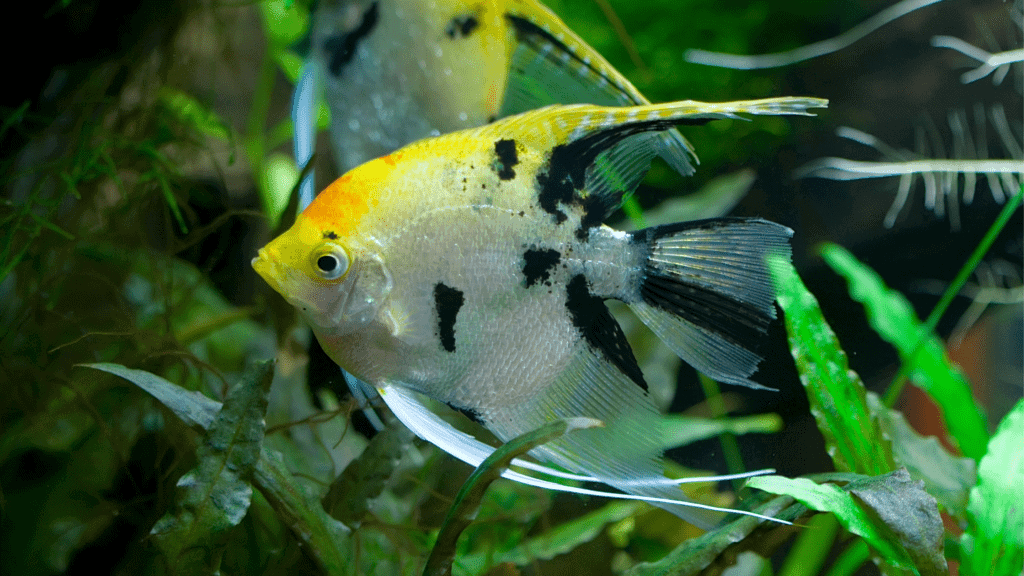
The gold marble angelfish is a hybrid type of angelfish that is created by breeding common angelfish with gold gene angelfish. They are not found in the wild and are exclusively found in the aquarium trade.
Gold marble ange fish are characterized by their tall, triangular body shape and long, flowing fins. They have a distinctive marbled pattern on their body, which is predominantly gold in color. They also have a distinctive eyespot on their dorsal fin, similar to the common, silver, and marble angelfish.
In terms of size, gold marble angelfish can grow up to 6 inches in length. They have a lifespan of around 5-10 years, depending on their care and environment.
Gold marble angelfish are generally peaceful and can be kept with other peaceful fish. However, they can be territorial and may become aggressive towards other angelfish if they are not given enough space. They are also known to nip at the fins of other fish, so it is important to provide them with plenty of hiding places and swimming space.
In terms of care, gold marble angelfish require a well-maintained and heavily planted aquarium with a pH of 6.5-7.5 and a temperature of 78-82 degrees Fahrenheit. They should be fed a varied diet of high-quality flakes, pellets, and frozen or live foods. They also require regular partial water changes and a good filtration system to maintain proper water quality.
Zebra Angelfish (Pterophyllum sp.)
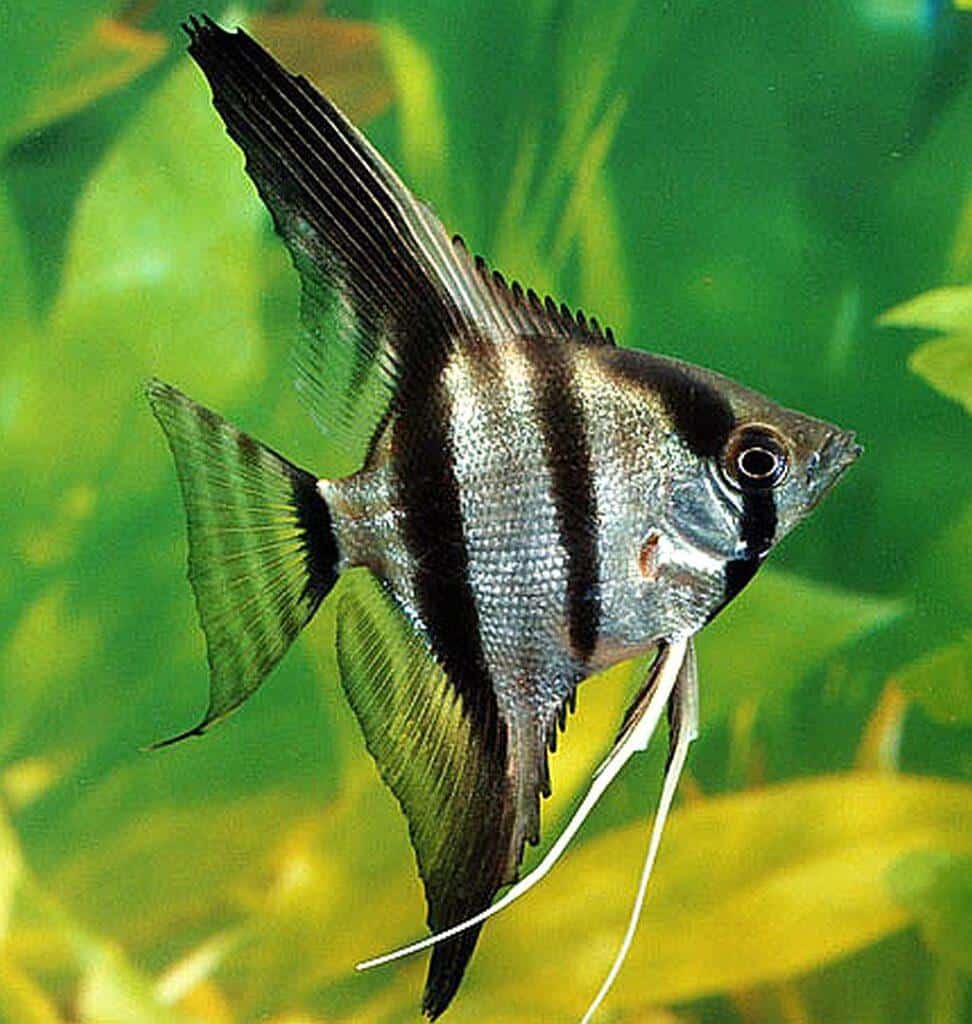
The zebra angelfish is a hybrid type of angelfish that is created by breeding common angelfish with zebra gene angelfish. They are not found in the wild and are exclusively found in the aquarium trade.
Zebra angelfish are characterized by their tall, triangular body shape and long, flowing fins. They have a distinctive zebra-like pattern on their body, which is predominantly black and white in color. They also have a distinctive eyespot on their dorsal fin, similar to the common, silver, marble, and gold marble angelfish.
In terms of size, zebra angelfish can grow up to 6 inches in length. They have a lifespan of around 5-10 years, depending on their care and environment.
Zebra angelfish are generally peaceful and can be kept with other peaceful fish. However, they can be territorial and may become aggressive towards other angelfish if they are not given enough space. They are also known to nip at the fins of other fish, so it is important to provide them with plenty of hiding places and swimming space.
In terms of care, zebra angelfish require a well-maintained and heavily planted aquarium with a pH of 6.5-7.5 and a temperature of 78-82 degrees Fahrenheit. They should be fed a varied diet of high-quality flakes, pellets, and frozen or live foods. They also require regular partial water changes and a good filtration system to maintain proper water quality.
Koi Angelfish (Pterophyllum sp.)
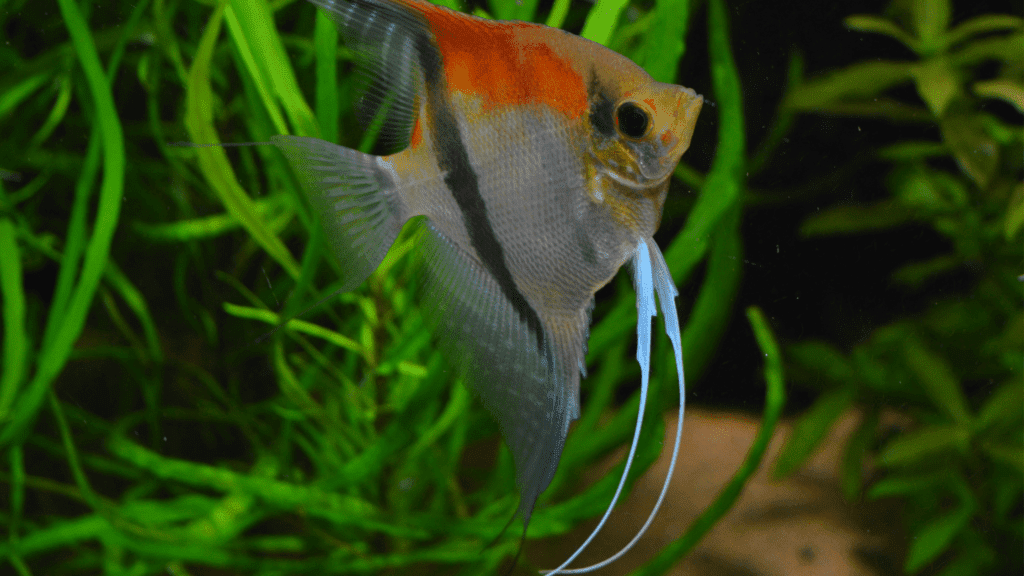
The koi angelfish is a hybrid type of angelfish that is created by breeding common angelfish with koi gene angelfish. They are not found in the wild and are exclusively found in the aquarium trade.
Koi angelfish are characterized by their tall, triangular body shape and long, flowing fins. They have a distinctive koi-like pattern on their body, which can range in color from orange to red to black. They also have a distinctive eyespot on their dorsal fin, similar to the other types of angelfish.
In terms of size, koi angelfish can grow up to 6 inches in length. They have a lifespan of around 5-10 years, depending on their care and environment.
Koi angelfish are generally peaceful and can be kept with other peaceful fish. However, they can be territorial and may become aggressive towards other angelfish if they are not given enough space. They are also known to nip at the fins of other fish, so it is important to provide them with plenty of hiding places and swimming space.
In terms of care, koi angelfish require a well-maintained and heavily planted aquarium with a pH of 6.5-7.5 and a temperature of 78-82 degrees Fahrenheit. They should be fed a varied diet of high-quality flakes, pellets, and frozen or live foods. They also require regular partial water changes and a good filtration system to maintain proper water quality.
Pearlscale Angelfish (Pterophyllum sp.)
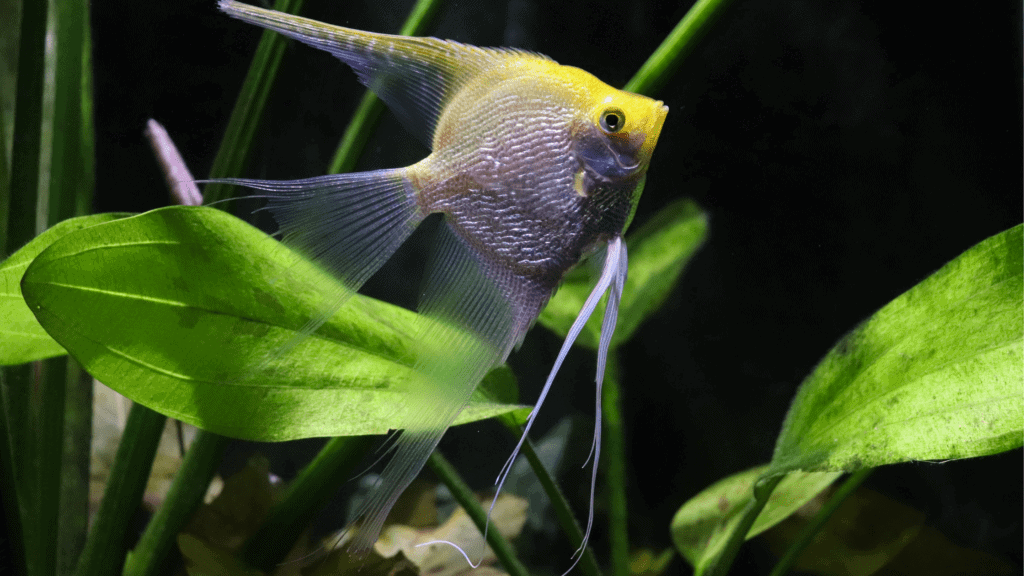
The pearlscale angelfish is a hybrid type of angelfish that is created by breeding common angel ish with pearlscale gene angelfish. They are not found in the wild and are exclusively found in the aquarium trade.
Pearlscale angelfish are characterized by their tall, triangular body shape and long, flowing fins. They have a distinctive pearlscale-like pattern on their body, which is characterized by small, round scales that give the appearance of pearls. They also have a distinctive eyespot on their dorsal fin, similar to the other types of angelfish.
In terms of size, pearlscale angelfish can grow up to 6 inches in length. They have a lifespan of around 5-10 years, depending on their care and environment.
Pearlscale angelfish are generally peaceful and can be kept with other peaceful fish. However, they can be territorial and may become aggressive towards other angelfish if they are not given enough space. They are also known to nip at the fins of other fish, so it is important to provide them with plenty of hiding places and swimming space.
In terms of care, pearlscale angelfish require a well-maintained and heavily planted aquarium with a pH of 6.5-7.5 and a temperature of 78-82 degrees Fahrenheit. They should be fed a varied diet of high-quality flakes, pellets, and frozen or live foods. They also require regular partial water changes and a good filtration system to maintain proper water quality.
Platinium Angelfish (Pterophyllum sp.)

The platinum angelfish is a hybrid type of angelfish that is created by breeding common angelfish with platinum gene angelfish. They are not found in the wild and are exclusively found in the aquarium trade.
Platinum angelfish are characterized by their tall, triangular body shape and long, flowing fins. They have a distinctive platinum-like coloration, which is characterized by a silvery-white color with a metallic sheen. They also have a distinctive eyespot on their dorsal fin, similar to the other types of angelfish.
In terms of size, platinum angelfish can grow up to 6 inches in length. They have a lifespan of around 5-10 years, depending on their care and environment.
Platinum angelfish are generally peaceful and can be kept with other peaceful fish. However, they can be territorial and may become aggressive towards other angelfish if they are not given enough space. They are also known to nip at the fins of other fish, so it is important to provide them with plenty of hiding places and swimming space.
In terms of care, platinum angelfish require a well-maintained and heavily planted aquarium with a pH of 6.5-7.5 and a temperature of 78-82 degrees Fahrenheit. They should be fed a varied diet of high-quality flakes, pellets, and frozen or live foods. They also require regular partial water changes and a good filtration system to maintain proper water quality.
In conclusion, there are many different types of angelfish available, each with its own unique characteristics and care requirements. Whether you are a seasoned aquarist or a beginner, there is an angelfish type that is suitable for you. With proper care and maintenance, angelfish can thrive in your aquarium and bring beauty and enjoyment for many years to come.
Black Lace Angelfish (Pterophyllum sp.)
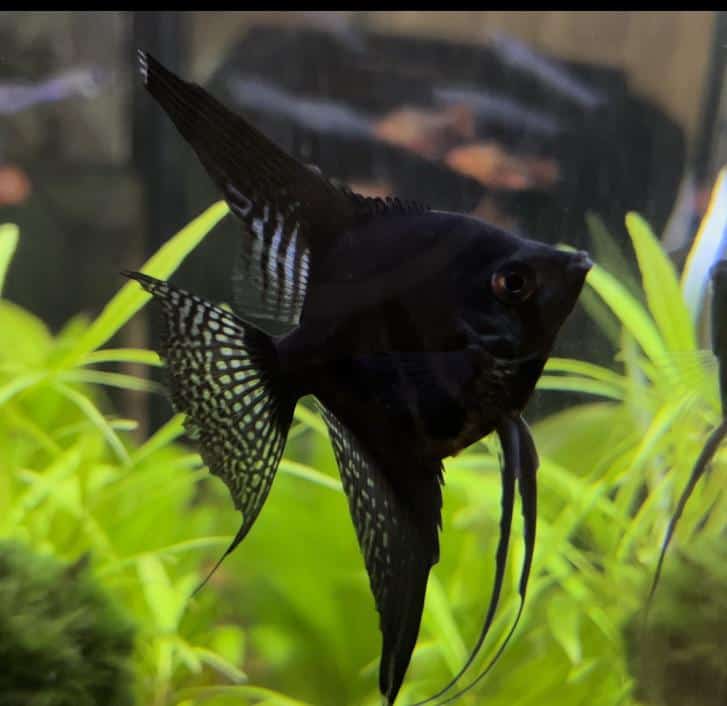
The black lace angelfish is a hybrid type of angelfish that is created by breeding common angelfish with black lace gene angelfish. They are not found in the wild and are exclusively found in the aquarium trade.
Black lace angelfish are characterized by their tall, triangular body shape and long, flowing fins. They have a distinctive black lace-like pattern on their body, which is characterized by a black color with a lacy or filigree-like pattern. They also have a distinctive eyespot on their dorsal fin, similar to the other types of angelfish.
In terms of size, black lace angelfish can grow up to 6 inches in length. They have a lifespan of around 5-10 years, depending on their care and environment.
Black lace angelfish are generally peaceful and can be kept with other peaceful fish. However, they can be territorial and may become aggressive towards other angelfish if they are not given enough space. They are also known to nip at the fins of other fish, so it is important to provide them with plenty of hiding places and swimming space.
In terms of care, black lace angelfish require a well-maintained and heavily planted aquarium with a pH of 6.5-7.5 and a temperature of 78-82 degrees Fahrenheit. They should be fed a varied diet of high-quality flakes, pellets, and frozen or live foods. They also require regular partial water changes and a good filtration system to maintain proper water quality.
Half Black Angelfish (Pterophyllum sp.)
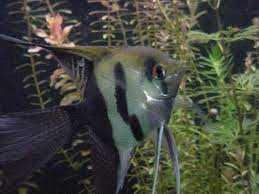
The half black angelfish is a hybrid type of angelfish that is created by breeding common angelfish with half black gene angelfish. They are not found in the wild and are exclusively found in the aquarium trade.
Half black angelfish are characterized by their tall, triangular body shape and long, flowing fins. They have a distinctive half black pattern on their body, which is characterized by a black color on the top half of their body and a different color on the bottom half. They also have a distinctive eyespot on their dorsal fin, similar to the other types of angelfish.
In terms of size, half black angelfish can grow up to 6 inches in length. They have a lifespan of around 5-10 years, depending on their care and environment.
Half black angelfish are generally peaceful and can be kept with other peaceful fish. However, they can be territorial and may become aggressive towards other angelfish if they are not given enough space. They are also known to nip at the fins of other fish, so it is important to provide them with plenty of hiding places and swimming space.
In terms of care, half black angelfish require a well-maintained and heavily planted aquarium with a pH of 6.5-7.5 and a temperature of 78-82 degrees Fahrenheit. They should be fed a varied diet of high-quality flakes, pellets, and frozen or live foods. They also require regular partial water changes and a good filtration system to maintain proper water quality.
Smokey Angelfish (Pterophyllum sp.)
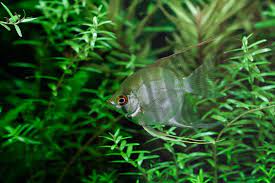
The smokey angelfish is a hybrid type of angelfish that is created by breeding common angelfish with smokey gene angelfish. They are not found in the wild and are exclusively found in the aquarium trade.
Smokey angel ish are characterized by their tall, triangular body shape and long, flowing fins. They have a distinctive smokey-gray coloration, which gives them a unique and striking appearance. They also have a distinctive eyespot on their dorsal fin, similar to the other types of angelfish.
In terms of size, smokey angelfish can grow up to 6 inches in length. They have a lifespan of around 5-10 years, depending on their care and environment.
Smokey angelfish are generally peaceful and can be kept with other peaceful fish. However, they can be territorial and may become aggressive towards other angelfish if they are not given enough space. They are also known to nip at the fins of other fish, so it is important to provide them with plenty of hiding places and swimming space.
In terms of care, smokey angelfish require a well-maintained and heavily planted aquarium with a pH of 6.5-7.5 and a temperature of 78-82 degrees Fahrenheit. They should be fed a varied diet of high-quality flakes, pellets, and frozen or live foods. They also require regular partial water changes and a good filtration system to maintain proper water quality.
Leopard Angelfish (Pterophyllum sp.)
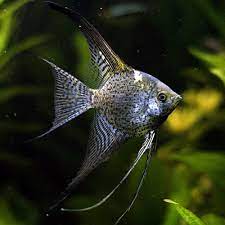
The leopard angelfish is a hybrid type of angelfish that is created by breeding common angelfish with leopard gene angelfish. They are not found in the wild and are exclusively found in the aquarium trade.
Leopard angelfish are characterized by their tall, triangular body shape and long, flowing fins. They have a distinctive leopard-like pattern on their body, which is characterized by a series of black spots on a lighter colored background. They also have a distinctive eyespot on their dorsal fin, similar to the other types of angelfish.
In terms of size, leopard angel fish can grow up to 6 inches in length. They have a lifespan of around 5-10 years, depending on their care and environment.
Leopard angelfish are generally peaceful and can be kept with other peaceful fish. However, they can be territorial and may become aggressive towards other angel ish if they are not given enough space. They are also known to nip at the fins of other fish, so it is important to provide them with plenty of hiding places and swimming space.
In terms of care, leopard angelfish require a well-maintained and heavily planted aquarium with a pH of 6.5-7.5 and a temperature of 78-82 degrees Fahrenheit. They should be fed a varied diet of high-quality flakes, pellets, and frozen or live foods. They also require regular partial water changes and a good filtration system to maintain proper water quality.
Conclusion
Angelfish are a popular and vibrant addition to any freshwater aquarium. With a variety of species and color variations to choose from, there is an angelfish to suit every aquarist’s taste. The key to keeping angelfish healthy and happy is to provide them with a suitable tank environment and diet, as well as regular water changes. By understanding the unique characteristics and needs of each type of angelfish, hobbyists can ensure that their fish thrive and bring a beautiful, exotic touch to their home.
FAQs
What are freshwater Angelfish?
Freshwater Angelfish are a group of cichlid fish native to South America, known for their graceful fins and unique shapes. They are popular in aquariums due to their striking appearance and interesting behaviors.
How many types of freshwater Angelfish are there?
There are three main species: Pterophyllum scalare, Pterophyllum altum, and Pterophyllum leopoldi, with many varieties bred for different colors and patterns.
What is the Koi Angelfish?
The Koi Angelfish resembles koi goldfish with shades of white, orange, and gold, and its color changes with mood. They require a minimum of a 30-gallon tank.
What conditions do Silver Angelfish prefer?
Silver Angelfish, known for their resilience and ease of care, prefer water temperatures between 72 to 82°F and a pH of 6.0 to 7.5.
Can you describe the Leopard Angelfish?
Leopard Angelfish have a tall, compressed body with elongated fins, adorned with black or dark brown spots on a golden or silver body.
What are the characteristics of Golden Angelfish?
Golden Angelfish have a rich, metallic gold color, bringing splendor to aquariums. They prefer moderate conditions and are somewhat uncommon.
How do Chocolate Angelfish look?
Chocolate Angelfish derive from the Smokey color form, featuring a deep brown color over their entire body.
What makes Ghost Angelfish unique?
Ghost Angelfish lack dark pigmentation, offering a distinctive appearance with their solid color and lack of bands or spots.
Are Angelfish prone to specific diseases?
Angelfish can suffer from conditions like dropsy and fin rot, which require proper treatment and tank management.
What are good tank mates for Angelfish?
Compatible tank mates include other Angelfish, certain cichlids, dwarf gouramis, mollies, plecos, and pictus catfish.
How should an Angelfish tank be set up?
Angelfish tanks should mimic their natural habitat with plenty of swimming space, territories, and suitable plants like Amazon Sword and Java Ferns.
What is the diet of freshwater Angelfish?
They thrive on a diet of small live prey, high-protein fish flakes or pellets, and a small amount of plant food.
What is the Blushing Angelfish?
Blushing Angelfish have a predominantly silver or white body with a delicate, rosy hue across their gills and upper body.
Describe the care needs for Platinum Angelfish.
Platinum Angelfish are easy to care for, preferring water temperatures of 75–82°F and a tank size of 30 gallons. They have a lifespan of about 10 years.
What is the Albino Angelfish?
Albino Angelfish are known for their moderate care level and semi-aggressive temperament. They have a unique, pale appearance with a lifespan of up to 10 years.
How do you identify a healthy Angelfish?
Healthy Angelfish should have bright, clear eyes, clean fins, and an active swimming behavior. Avoid fish with visible signs of illness or distress.
Can Angelfish live with Betta fish?
Due to their territorial nature, it’s generally not recommended to house Angelfish with Betta fish as they may become aggressive towards each other.
How often should Angelfish be fed?
Feed Angelfish twice daily, providing only as much food as they can consume in a few minutes to avoid overfeeding and water quality issues.
What is the maximum size of a freshwater Angelfish?
Depending on the species, freshwater Angelfish can grow up to 6 inches in length, with some varieties reaching even larger sizes in optimal conditions.
How do you breed freshwater Angelfish?
Breeding requires a pair of sexually mature Angelfish, a suitable breeding tank, and optimal water conditions. Angelfish typically lay eggs on a flat surface, which are then fertilized by the male.
Do Angelfish need a heater in their tank?
Yes, Angelfish require a heater to maintain water temperatures between 75–85°F, which is crucial for their health and well-being.
Can Angelfish change color?
Some Angelfish, like the Koi Angelfish, can change color based on their mood, with the orange tone darkening as they grow more agitated.
How long do freshwater Angelfish live?
Freshwater Angelfish can live up to 10 years in well-maintained aquarium conditions.
What is the rarest type of Angelfish?
The Diamond Gold Angelfish is considered rare and highly sought-after due to its ethereal beauty and diamond-dusted appearance.
How many Angelfish should be kept together?
To avoid territorial disputes, it’s recommended to keep Angelfish in groups of up to six in a sufficiently large tank.
Do Angelfish eat other fish?
Angelfish might prey on smaller fish or invertebrates in the tank, so it’s essential to choose tank mates that are not too small or vulnerable.
How many times a day should you feed Angelfish?
Angelfish should be fed at least two times a day with a diet that includes a variety of foods to ensure they receive all necessary nutrients.
Can you mix different types of Angelfish together?
Yes, different types of Angelfish can generally be mixed together, as long as the tank is large enough and properly set up to accommodate their needs.
What is the minimum tank size for Angelfish?
The minimum recommended tank size for Angelfish is 30 gallons, providing enough space for them to swim freely and establish territories.
How can you tell the difference between male and female Angelfish?
Sexing Angelfish can be challenging, but males are generally larger and have a more pointed papilla during breeding season. Observing their behavior during breeding can also provide clues
References
International Federation of Online Clubs and Aquatic Societies (IFOCAS)
Federation of British Aquatic Societies (FBAS)
Northeast Council of Aquarium Societies (NEC)
Federation of American Aquarium Societies (FAAS)
The South American Cichlid Association (SACA)
The American Cichlid Association (ACA)
If you are interested you can also check out my other article on Angelfish
A Complete Guide to Breeding Angel Fish and How to Create the Perfect Living Environment
Master Breeding Techniques for Angelfish – A Guide for Hobbyists
Do Angel Fish Need a Heater? Find Out Here!
A Comprehensive Guide to Different Types of Angelfish
All You Need to Know About Keeping Angel Fish in Your Aquarium
I am a passionate aquarist with over 30 years of hands-on experience in fishkeeping. My journey began at a young age, collecting fish from the wild and learning through experimentation. Specializing in tropical fish, I bring a deep understanding of the hobby to FishKeepingMadeSimple. The site provides honest, detailed reviews of essential products and accessories to help fellow enthusiasts create the best environments for their fish.

